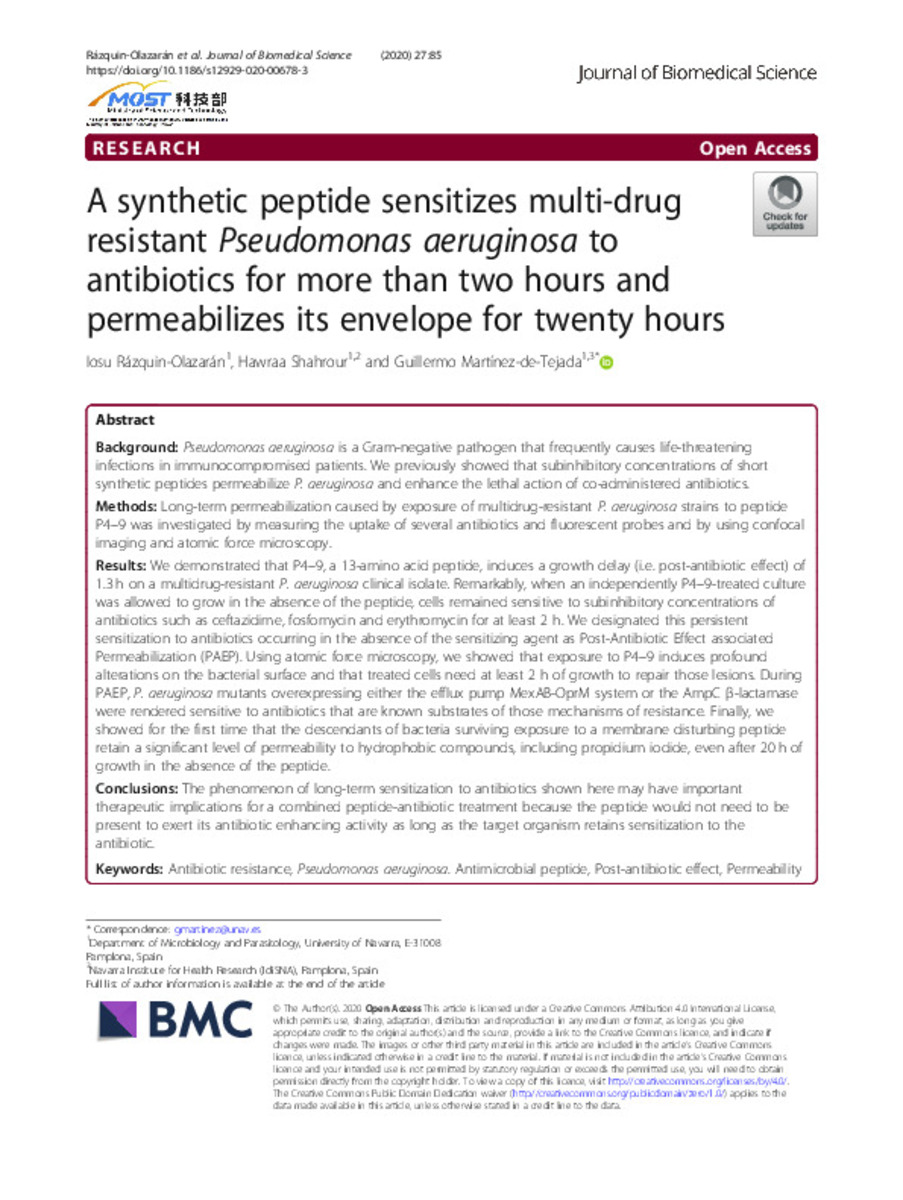Full metadata record
| DC Field | Value | Language |
|---|---|---|
| dc.creator | Razquin-Olazaran, I. (Iosu) | - |
| dc.creator | Shahrour, H. (Hawraa) | - |
| dc.creator | Martinez-de-Tejada, G. (Guillermo) | - |
| dc.date.accessioned | 2023-01-30T12:48:24Z | - |
| dc.date.available | 2023-01-30T12:48:24Z | - |
| dc.date.issued | 2020 | - |
| dc.identifier.citation | Razquin-Olazaran, I. (Iosu); Shahrour, H. (Hawraa); Martinez-de-Tejada, G. (Guillermo). "A synthetic peptide sensitizes multi-drug resistant pseudomonas aeruginosa to antibiotics for more than two hours and permeabilizes its envelope for twenty hours". Journal of Biomedical Science. 27:85, 2020, | es_ES |
| dc.identifier.issn | 1423-0127 | - |
| dc.identifier.uri | https://hdl.handle.net/10171/65197 | - |
| dc.description.abstract | Background: Pseudomonas aeruginosa is a Gram-negative pathogen that frequently causes life-threatening infections in immunocompromised patients. We previously showed that subinhibitory concentrations of short synthetic peptides permeabilize P. aeruginosa and enhance the lethal action of co-administered antibiotics. Methods: Long-term permeabilization caused by exposure of multidrug-resistant P. aeruginosa strains to peptide P4–9 was investigated by measuring the uptake of several antibiotics and fluorescent probes and by using confocal imaging and atomic force microscopy. Results: We demonstrated that P4–9, a 13-amino acid peptide, induces a growth delay (i.e. post-antibiotic effect) of 1.3 h on a multidrug-resistant P. aeruginosa clinical isolate. Remarkably, when an independently P4–9-treated culture was allowed to grow in the absence of the peptide, cells remained sensitive to subinhibitory concentrations of antibiotics such as ceftazidime, fosfomycin and erythromycin for at least 2 h. We designated this persistent sensitization to antibiotics occurring in the absence of the sensitizing agent as Post-Antibiotic Effect associated Permeabilization (PAEP). Using atomic force microscopy, we showed that exposure to P4–9 induces profound alterations on the bacterial surface and that treated cells need at least 2 h of growth to repair those lesions. During PAEP, P. aeruginosa mutants overexpressing either the efflux pump MexAB-OprM system or the AmpC β-lactamase were rendered sensitive to antibiotics that are known substrates of those mechanisms of resistance. Finally, we showed for the first time that the descendants of bacteria surviving exposure to a membrane disturbing peptide retain a significant level of permeability to hydrophobic compounds, including propidium iodide, even after 20 h of growth in the absence of the peptide. Conclusions: The phenomenon of long-term sensitization to antibiotics shown here may have important therapeutic implications for a combined peptide-antibiotic treatment because the peptide would not need to be present to exert its antibiotic enhancing activity as long as the target organism retains sensitization to the antibiotic. | es_ES |
| dc.description.sponsorship | We are indebted to the German Ministry (Bundesministerium für Bildung und Forschung) BMBF, project 01GU0824, and the Else-Kröner-Fresenius-Stiftung, project 2011_A140, for financial help. G.M.T. was funded by a grant from Ministerio de Sanidad y Consumo (FIS-PI050768), from Proyectos de Investigación Universidad de Navarra (PIUNA-P2008–11 and PIUNA-P2011–17), Spain. I.R.O. was the recipient of a predoctoral fellowship from Gobierno de Navarra, Spain. | es_ES |
| dc.language.iso | spa | es_ES |
| dc.publisher | Springer | es_ES |
| dc.relation | FIS-PI050768 | es_ES |
| dc.relation | PIUNA-P2008–11 | es_ES |
| dc.relation | PIUNA-P2011– 17 | es_ES |
| dc.rights | info:eu-repo/semantics/openAccess | es_ES |
| dc.subject | Antibiotic resistance | es_ES |
| dc.subject | Pseudomonas aeruginosa | es_ES |
| dc.subject | Antimicrobial peptide | es_ES |
| dc.subject | Post-antibiotic effect | es_ES |
| dc.subject | Permeability | es_ES |
| dc.title | A synthetic peptide sensitizes multi-drug resistant pseudomonas aeruginosa to antibiotics for more than two hours and permeabilizes its envelope for twenty hours | es_ES |
| dc.type | info:eu-repo/semantics/article | es_ES |
| dc.description.note | This article is licensed under a Creative Commons Attribution 4.0 International License | es_ES |
| dc.identifier.doi | 10.1186/s12929-020-00678-3 | - |
| dadun.citation.publicationName | Journal of Biomedical Science | es_ES |
| dadun.citation.startingPage | 85 | es_ES |
| dadun.citation.volume | 27 | es_ES |
| dc.identifier.pmid | 32762680 | - |
Files in This Item:
Statistics and impact
Items in Dadun are protected by copyright, with all rights reserved, unless otherwise indicated.






